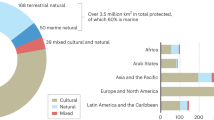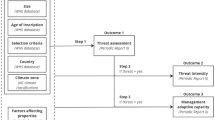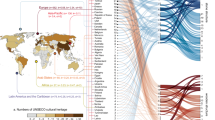Abstract
Climate change poses a rapidly growing threat to World Heritage sites, making effective adaptation strategies essential. However, the extent to which climate adaptation strategies have been integrated into heritage conservation frameworks remains underexplored. Applying text mining and large language models to analyse 535 World Heritage sites, we assess climate awareness (vulnerability, adaptation and resilience) and local actions (policy, process, planning and management) across 1,868 World Heritage documents. We observe spatial differences in climate awareness, influenced by regional contexts and document characteristics. Climate awareness does not align neatly with national political or economic features. Local heritage management and planning actions are negatively associated with vulnerability awareness, while policies show positive associations with overall climate awareness. Our findings demonstrate that large language models are effective tools for text classification in the interdisciplinary field of heritage and climate and offer practical perspectives into the gap between awareness and action in heritage conservation.
This is a preview of subscription content, access via your institution
Access options
Access Nature and 54 other Nature Portfolio journals
Get Nature+, our best-value online-access subscription
$32.99 / 30 days
cancel any time
Subscribe to this journal
Receive 12 print issues and online access
$259.00 per year
only $21.58 per issue
Buy this article
- Purchase on SpringerLink
- Instant access to full article PDF
Prices may be subject to local taxes which are calculated during checkout


Similar content being viewed by others
Data availability
All the data used in this research are available via figshare at https://doi.org/10.6084/m9.figshare.28823297 (ref. 59). LCT and ABE can be found on the website of UNESCO WHC (https://whc.unesco.org/) as of December 2024.
Code availability
The code for data collection, processing and analysis is available via figshare at https://doi.org/10.6084/m9.figshare.28823297 (ref. 59).
References
Sustainable Development Goal 11.4 (UNESCO, 2023); https://uis.unesco.org/en/topic/sustainable-development-goal-11-4
Operational Guidelines for the Implementation of the World Heritage Convention (UNESCO WHC, 1977); https://whc.unesco.org/archive/opguide77a.pdf
Jokilehto, J. The World Heritage List. What is OUV? Defining the Outstanding Universal Value of Cultural World Heritage Properties (Hendrik Bäßler Verlag, 2008).
Court, S. et al. Guidance and Toolkit for Impact Assessments in a World Heritage Context (UNESCO, 2022).
Chen, G. et al. Natural world heritage sites are at risk from climate change globally. Commun. Earth Environ. 5, 760 (2024).
Reimann, L., Vafeidis, A. T., Brown, S., Hinkel, J. & Tol, R. S. J. Mediterranean UNESCO World Heritage at risk from coastal flooding and erosion due to sea-level rise. Nat. Commun. 9, 4161 (2018).
Perry, J. & Gordon, I. J. Adaptive heritage: is this creative thinking or abandoning our values?. Climate 9, 128 (2021).
Lin, B. B. et al. Holistic climate change adaptation for World Heritage. Nat. Sustain. 6, 1157–1165 (2023).
Chen, Y., Zhang, L. & Dong, Q. Using natural language processing to evaluate local conservation text: a study of 624 documents from 303 sites of the World Heritage Cities Programme. J. Cult. Herit. 70, 259–270 (2024).
Lamb, W. F., Creutzig, F., Callaghan, M. W. & Minx, J. C. Learning about urban climate solutions from case studies. Nat. Clim. Change 9, 279–287 (2019).
Callaghan, M. et al. Machine-learning-based evidence and attribution mapping of 100,000 climate impact studies. Nat. Clim. Change 11, 966–972 (2021).
Devlin, J., Chang, M.-W., Lee, K. & Toutanova, K. BERT: pre-training of deep bidirectional transformers for language understanding. In Proc. 2019 Conference of the North American Chapter of the Association for Computational Linguistics: Human Language Technologies (eds Burstein, J. et al.) 4171–4186 (Association for Computational Linguistics, 2019).
Fu, X., Wang, R. & Li, C. Can ChatGPT evaluate plans?. J. Am. Plan. Assoc. 1, 12 (2023).
Fu, X. Natural language rocessing in urban planning: a research agenda. J. Plan. Lit. 39, 395–407 (2024).
Nicola, J. ‘In awe’: scientists impressed by latest ChatGPT model o1. Nature 634, 275–276 (2024).
IPCC. Climate Change 2022: Impacts, Adaptation, and Vulnerability (eds Pörtner, H.-O. et al.) (Cambridge Univ. Press, 2022).
Climate Change and World Heritage (UNESCO WHC, 2023); https://whc.unesco.org/en/climatechange/
Format for the Nomination of Properties for Inscription on the World Heritage List (UNESCO WHC, 2005); https://whc.unesco.org/document/191594
State of Conservation Information System (UNESCO WHC, accessed 20 February 2025); https://whc.unesco.org/en/soc/
Periodic Reporting (UNESCO WHC, accessed 20 February 2025); https://whc.unesco.org/en/periodicreporting/
Climate Change Adaptation for Natural World Heritage Sites—A Practical Guide (UNESCO WHC, 2014); https://whc.unesco.org/document/129276
The Future of our Pasts: Engaging Cultural Heritage in Climate Action (ICOMOS, 2019); https://civvih.icomos.org/wp-content/uploads/Future-of-Our-Pasts-Report-min.pdf
Wang, X. M., Li, H. M., Wang, Y. F. & Zhao, X. F. Assessing climate risk related to precipitation on cultural heritage at the provincial level in China. Sci. Total Environ. 835, 155489 (2022).
Banda, A. M., Banda, K., Sakala, E., Chomba, M. & Nyambe, I. A. Assessment of land use change in the wetland of Barotse Floodplain, Zambezi River Sub-Basin, Zambia. Nat. Hazards 115, 1193–1211 (2023).
Vandemeulebroucke, I., Vanderschelden, B., Janssens, K., Caluwaerts, S. & Van Den Bossche, N. The impact of climate change on degradation in historical building envelopes: progress in research using hygrothermal models. J. Cult. Herit. 70, 345–363 (2024).
Wartman, M. et al. Assessing blue carbon in mangrove ecosystems of Seychelles. J. Environ. Manag. 374, 123967 (2025).
Lelièvre, Y. et al. Taxonomic and functional diversity of subtidal benthic communities associated with hard substrates at Crozet archipelago (sub-Antarctic, Southern Ocean). Front. Mar. Sci. 10, 1291038 (2023).
Liang, Q. F., Zhai, J. & Li, C. From separation to incorporation: development of a unifying framework that integrated bird habitats with public recreation spaces within the wetland park system. J. Clean. Prod. 430, 139647 (2023).
Khalaf, R. W. Integrity: enabling a future-oriented approach to cultural heritage. Hist. Environ. Policy 13, 5–27 (2022).
Richards, J., Brimblecombe, P. & Engelstaedter, S. Modelling temperature–precipitation pressures on African timber heritage. Int. J. Climatol. 43, 7447–7462 (2023).
Boellinghaus, T., Wentland, E., Jassmann, R., Keller, R. & Wolfrum, A. Conservation of the shaft #1 headgear at the Tsumeb Mine, Namibia: corrosion protection. Stud. Conserv. 68, 228–242 (2023).
Collareta, A. et al. Reviewing the palaeontological and palaeoenvironmental heritage of the Monti Pisani Massif (Italy): a compelling history of animals, plants and climates through three geological eras. Geosciences 13, 332 (2023).
Cerrillo-Cuenca, E. et al. Emergent heritage: the digital conservation of archaeological sites in reservoirs and the case of the Dolmen de Guadalperal (Spain). Herit. Sci. 9, 114 (2021).
Manunza, A. et al. Genetic diversity and historical demography of underutilised goat breeds in North-Western Europe. Sci. Rep. 13, 20728 (2023).
Chen, Y., Dong, Q., Zhang, L., Shao, L. & Tang, Y. Using natural language processing to identify and evaluate heritage value for buffer zone delineation in Hengdaohezi Town. npj Herit. Sci. 13, 262 (2025).
Chen, H., Zheng, Y., Xing, J. & Zhou, C. Urban planning priorities analysis based on urban heat risk supply–demand mismatch: a case study of Hangzhou, China. Sustain. Cities Soc. 130, 106502 (2025).
Zhang, L., Tang, Y. & Chen, Y. Integrating historic preservation into a wider framework of urban development through comprehensive planning: an evaluation of local comprehensive plans in U.S. state capitals. Herit. Sci. 10, 192 (2022).
Operational Guidelines for the Implementation of the World Heritage Convention (UNESCO WHC, 2005); https://whc.unesco.org/archive/opguide05-en.pdf
Feng, C. et al. Sustainably developing global blue carbon for climate change mitigation and economic benefits through international cooperation. Nat. Commun. 14, 6144 (2023).
Johnathan, G., Esther, S. & Jonas, M. Author correction: National models of climate governance among major emitters. Nat. Clim. Change 13, 748 (2023).
Callaghan, M. et al. Machine learning map of climate policy literature reveals disparities between scientific attention, policy density, and emissions. npj Clim. Action 4, 7 (2025).
Kim, J. S. & Kim, S. K. Ageing population and green space dynamics for climate change adaptation in Southeast Asia. Nat. Clim. Change 14, 490–495 (2024).
Chen, Z., Guo, W., Dai, L.-R., Ling, Z.-H. & Du, J. Neural text clustering with document-level attention based on dynamic soft labels. Proc. Interspeech 2019, 4225–4229 (2019).
Fornaciari, T., Uma, A., Poesio, M. & Hovy, D. Hard and soft evaluation of NLP models with BOOtSTrap SAmpling—BooStSa. In Proc. 60th Annual Meeting of the Association for Computational Linguistics: System Demonstrations (eds Basile, V. et al.) 127–134 (Association for Computational Linguistics, 2022).
Vaismoradi, M., Turunen, H. & Bondas, T. Content analysis and thematic analysis: implications for conducting a qualitative descriptive study. Nurs. Health Sci. 15, 398–405 (2013).
Zhang, L., Tochen, R. M., Hibbard, M. & Tang, Z. H. The role of local leaders in environmental concerns in master plans: an empirical study of China’s eighty large municipalities. J. Plan. Educ. Res. 38, 301–313 (2018).
Bai, N., Luo, R., Nourian, P. & Pereira Roders, A. WHOSe heritage: classification of UNESCO world heritage statements of ‘outstanding universal value’ with soft labels. In Findings of the Association for Computational Linguistics: EMNLP 2021 (eds Moens, M.-F. et al.) 366–384 (Association for Computational Linguistics, 2021).
Huber, M., Zollner, D., Pecher, S. & Wolf, L. Mid-Term Programme Evaluation: World Heritage Leadership—Final Evaluation Report (IUCN, 2023); https://www.iucn.org/sites/default/files/2022-05/world-heritage-leadership-mid-term-evaluation-2020.pdf
Wannewitz, M. et al. Progress and gaps in climate change adaptation in coastal cities across the globe. Nat. Cities 1, 610–619 (2024).
Deng, J. & Lin, Y. The benefits and challenges of ChatGPT: an overview. Front. Comput. Intel. Syst. 2, 81–83 (2023).
Sandmann, S., Riepenhausen, S., Plagwitz, L. & Varghese, J. Systematic analysis of ChatGPT, Google search and Llama 2 for clinical decision support tasks. Nat. Commun. 15, 2050 (2024).
Niu, Y. M., Wu, J., Jiang, S. Y. & Jiang, Z. B. The Bullwhip Effect in Servitized Manufacturers (SSRN, 2024).
World Heritage List (UNESCO WHC, 1978); https://whc.unesco.org/en/list/
Peel, M.C., Finlayson, B.L. & McMahon, T.A. Updated world map of the Köppen–Geiger climate classification. Hydrol. Earth Syst. Sci. 11, 1633–1644 (2007).
Advisory Bodies (UNESCO WHC, 1996); https://whc.unesco.org/en/advisorybodies/
Woodruff, S. C. & Stults, M. Numerous strategies but limited implementation guidance in US local adaptation plans. Nat. Clim. Change 6, 796–802 (2016).
Niraula, D. et al. Intricacies of human–AI interaction in dynamic decision-making for precision oncology. Nat. Commun. 16, 1138 (2025).
Chicco, D. & Jurman, G. The Matthews correlation coefficient (MCC) should replace the ROC AUC as the standard metric for assessing binary classification. BioData Min. 16, 4 (2023).
Yang, C. et al. World Heritage documents reveal persistent gaps between climate awareness and local action. figshare https://doi.org/10.6084/m9.figshare.28823297 (2025).
Acknowledgements
This work was supported by the National Natural Science Foundation of China (grant no. 52394222, C.S.), the National Key R&D Program-Strategic Scientific and Technological Innovation Cooperation (grant no. 2022YFE0208600, Q.D.), the Heilongjiang Touyan Innovation Team Program (C.S.) and the China Postdoctoral Science Foundation (grant no. 2024M754190, L.Z.). We are also grateful to X. Hou and Y. Liu for providing the artwork and to X. Xiao and G. Zhang for contributing the photography.
Author information
Authors and Affiliations
Contributions
Y.C. together with D.W., C.S. and Q.D. designed the work. Y.C. led the paper, wrote the draft and, together with D.W. and C.W., analysed the data. L.Z., Q.D. and C.S. substantively revised the draft. All other authors acquired and interpreted the data and edited the drafts.
Corresponding authors
Ethics declarations
Competing interests
The authors declare no competing interests.
Peer review
Peer review information
Nature Climate Change thanks Chris Ballard, Attila Buzási, Travis Coan and John Hughes for their contribution to the peer review of this work.
Additional information
Publisher’s note Springer Nature remains neutral with regard to jurisdictional claims in published maps and institutional affiliations.
Extended data
Extended Data Fig. 1 Distribution of WHS and their climate awareness.
a Geographic distribution across different themes of WHS (n = 562, including repeated values). Among the 535 WHS with valid climate awareness scores, 27 sites belong to multiple themes. b Distribution of climate awareness scores across different climate zone (n = 535). The different colors in the figure represent various regions, with the actual values corresponding to the average climate awareness scores for each region.
Supplementary information
Supplementary Information
Supplementary Figs. 1 and 2, Notes 1–8 and Tables 1–11.
Rights and permissions
Springer Nature or its licensor (e.g. a society or other partner) holds exclusive rights to this article under a publishing agreement with the author(s) or other rightsholder(s); author self-archiving of the accepted manuscript version of this article is solely governed by the terms of such publishing agreement and applicable law.
About this article
Cite this article
Chen, Y., Wang, D., Zhang, L. et al. World Heritage documents reveal persistent gaps between climate awareness and local action. Nat. Clim. Chang. (2025). https://doi.org/10.1038/s41558-025-02461-4
Received:
Accepted:
Published:
DOI: https://doi.org/10.1038/s41558-025-02461-4



